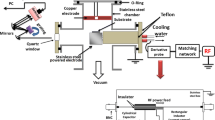Abstract.
Thin layers of hydrogenated amorphous carbon were prepared by using organic hydrocarbon source, xylene (C8H10), in plasma-enhanced chemical vapor deposition (PECVD) system. The microstructures were characterized by using Fourier-transform infrared and Raman scattering spectra. The appearance of a sharp vibration signal in 1600 cm-1 strongly suggests the existence of sp2 carbon clusters with aromatic rings. With increasing the deposition rf power, the content of these aromatic structures is increased in the films. In contrast to a broad single PL peak in methane (CH4)-baseda-C:H films, the PL band of xylene-based a-C:H films contains multiple peaks in blue-green light region, which is influenced by rf power. We tentatively attributed it to the radiative recombination of electron-hole pairs through some luminescent centers associated with aromatic structures.
Similar content being viewed by others
Author information
Authors and Affiliations
Additional information
Received: 26 April 2000 / Accepted: 9 May 2000 / Published online: 13 September 2000
Rights and permissions
About this article
Cite this article
Xu, J., Li, W., Ma, T. et al. Microstructures and photoluminescence of hydrogenated amorphous carbon films produced by using organic hydrocarbon source . Appl Phys A 71, 651–655 (2000). https://doi.org/10.1007/s003390000576
Issue Date:
DOI: https://doi.org/10.1007/s003390000576




